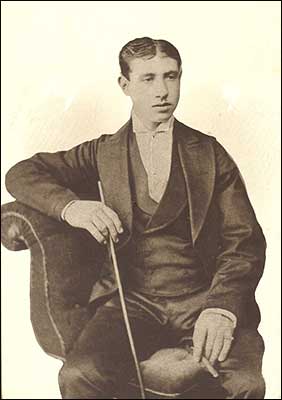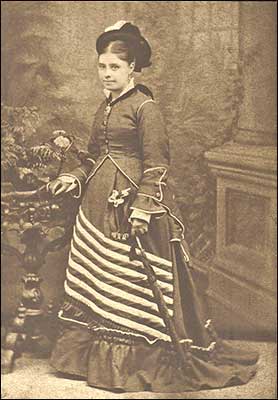Amelia (1857) and David Magee (1856) came to England from Belfast and lived in Northampton, where David worked as an Edge Setter. The first three children David, Malcolm & Frank were born there. They moved to Irchester where the next four children Rose, Albert, Dennis & Christopher were born, and then on to 74 Glassbrook Road, Rushden, where the youngest two children Amelia & Agnes were born. Amelia and David Magee both died young leaving the children to be brought up by various relatives.
The children were:
|
David Albert 23.07.1880
|
|
Malcolm 1884
|
|
(Vernon) Frank 1886
|
|
Rose 12.02.1888
|
|
Christopher 13.02.1892
|
|
Albert Married Louisa Dorothy Hellsdown 2.05.1914
|
|
Dennis Patrick 12th or 18th 05.1897
|
|
Amelia (Biddy) 22.01.1899
|
|
Agnes 1900
|
David transferred to Moor Road school on 23 July 1894 and left there 1 May 1901. He brought up Agnes, his youngest sister.
Malcom was a Shoe Finisher and was killed during the First World War when he was 32 years old.
Frank was a Rivetter, and he too was killed in WWI on the 9th May 1915, aged 28 years.
Rose transferred from Irchester school on 19 April 1898, around which time it is thought the family moved to Rushden.
Dennis started at North End Council School on 1 May 1906 when he lived at 80 Glassbrook Road, Rushden with his Guardian, Kate (? Richardson). He left there on 30 October 1908 under Doctor's orders as an invalid and was re-admitted 10 January 1910, at which time he lived with his Guardian James Richardson at 96 GlassbrookRoad, Rushden. He finally left school on 23 May 1910 and entered "Catholic House".
Albert is reported to have served at the altar at Rushden Roman Catholic Church. During his working life became Foreman at Eaton's Shoes in Irchester Road, Rushden.
Amelia (Biddy) went to live with her aunt Mrs Emily Bridgeford (nee Smith) at the age of 2½. Mrs Bridgeford's sister lived near Northampton Race Course.
Christopher Magee went to Moor Road Infant School until he transferred to Alfred Street school on 1st May 1899. He left school to start work on 17 October 1905. Christopher married Ivy and they had three children, five grandchildren and three great-grandchildren. He worked at Grenson's shoe factory until he retired. He lived to be 101 years age and put his longevity down to a tot of whisky in his tea each morning!
Christopher was based at Kempston Barracks when he first joined the army as a private in 1910, in the Frist Battalion of the Bedfordshire Regiment. He had been one of the guards of honour in 1910 lining theLondon funeral route of King Edward V11. Among the mourners he saw walking together that day were Lord Kitchiner and Kaiser Wilhelm, who became leaders of the two armies that lined up against each other for the war that was supposed to end all wars.
Christopher Magee was a survivor of the battle of Ypres and recalled the horrors. When war was declared in August 1914 he was based in South Africa, but was mobilised soon afterwards and sailed for England on the Kennilworth Castle.
Back home he and his comrades became part of the Second Battalion, which in its turn formed part of the 21st Infantry Brigade of the 7th Division under the overall command of Lieutenant-General Sir Henry Rawlinson. He and his battalion embarked from Dover on the Winefredian to Zeebrugge in October 1910. Their job was to get to the Belgian port of Antwerp and to relieve the town, but by the time they arrived it had fallen to the Germans.
So Christopher and his mates were ordered on a 14 day march westwards to join up with the British Expeditionary Force in Ypres. “We marched night and day without hardly stopping” said Christopher. He arrived in time for the first Battle of Ypres in October of that year. This was before either side had had time to build trenches, and as they tried to out manoeuvre each other the casualties built up.
The British were short of machine guns, but the men’s rapid rifle fire fooled the Germans into thinking they had then. Then came the fateful day when Christopher himself was wounded on October 29 1914, making him one of the 50,000 British casualties of that action. He and his mates had been facing murderous machine fun fire from the Germans when a bullet ripped through his left arm.
“The Germans were breaching the line and the adjutant wanted volunteers to stop them. I said I would go" he said. “There were no trenches, we were lying out in the open with our Lee Enfield rifles, the same ones that head been used in the Boer War. We gave them such rapid fire they thought we had machine guns. I was reloading my rifle when I was shot in the left shoulder. I couldn’t move, otherwise they would have got me, so I had to lie low until dusk then crawl back to my lines. It was nothing more than murder. The surgeon told me that if the bullet had gone another eighth of an inch towards my heart it would have got a main artery and I would have bled to death. “You’re a lucky fellow Magee”, he said. “And I knew I was”.
Christopher was evacuated back to England and his war was effectively over. He was in hospital for six months, and the army kept him on as a shoemaker – the same job he had done in civvy street. He was demobbed in 1919 as a sergeant and eventually settled in Rushden.
He returned to Ypres after the 1939-45 conflict and was surprised to find that it looked the same as he remembered it. Trying to read all the names on the Menin Gate was a poignant reminder of what he and his comrades had been through. “They went so far up that you couldn’t see them all”, he said. Looking back on it all, the overriding memory Christopher had of his time under fire was how brutal it could make even the gentlest of men.
“When you see your pals killed, it made you more vicious than ever, I can tell you. That was the worst thing about it” he said.

